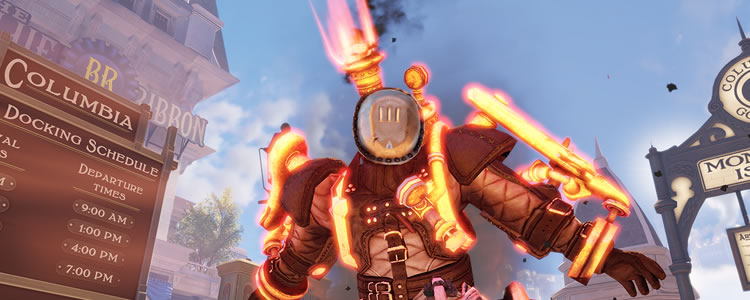Average FPS vs. Frame Times: A Big Gap
BioShock Infinite is an impressive game that's been well designed to take full advantage of the latest and greatest computer hardware. The benchmark results featured in this article are based on the maximum graphics settings as we wanted to see what it takes to play BioShock Infinite in all of its glory.
Looking solely at the frames per second data for a moment BioShock Infinite doesn't look overly demanding, at least for a DX11 title. For example, at 1680x1050 the GeForce GTX 650 Ti (a $150 card) averaged 41fps and at 1920x1200 the GeForce GTX 660 ($200) averaged 46fps. Although things became quite demanding at 2560x1600 it was still possible to play at 41fps with the GeForce GTX 670.
However, if we look at frame time performance things look a lot different. As we just mentioned the GeForce GTX 660 averaged 46fps according to our frames per second data at 1920x1200. When measuring frame time performance in milliseconds that same graphics card only managed 29fps, a 37% reduction in fps.
It isn't uncommon to see a gap between frame time performance and average frames per second, but we generally observe a smaller 5 - 10 fps reduction with the former. With BioShock Infinite the margins were massive, anywhere from 10 to 30fps.
Case in point, the GeForce GTX 680 averaged 46fps in our frames per second test at 2560x1600. But when we measured frame times in milliseconds we got 40ms which equates to just 25fps, a 46% reduction in performance. It was a similar story with the Radeon HD 7970 GHz Edition (49% reduction in performance).
It's safe to assume both both AMD and Nvidia will be working on game-specific optimizations in the coming weeks, putting BioShock Infinite performance where it should be. On that note we also feel AMD has a little more work to do than Nvidia, as their GPUs appear to be underperforming even in the frames per second tests.
Putting GPU scores aside for a moment, we found that BioShock Infinite isn't very CPU demanding and in fact it's one of the few games that we have tested in recent times that can be played quite well on a dual-core processor. Those hoping to squeeze more performance out of their gaming rig for BioShock Infinite need only turn to their GPU, as CPU overclocking is unlikely to improve performance.
Back to the graphics cards, we are interested to see how the next driver release from AMD and Nvidia handles frame latency performance. There's currently great disparity on how to properly measure graphics card performance, considering some of Fraps' shortcomings (the current standard for testing average frames per second), the question that frame time performance raises, particularly on multi-GPU setups, and up and coming test tools like Nvidia's FCAT.
Having that said, we still play games ourselves, Bioshock Infinite included, and we believe the data we are showing accurately represents a comparison between GPUs and what you need to play the game smoothly. Based on current driver's performance, for playing at 1920x1200/1920x1080 you'll at least want a Radeon HD 7870 or GeForce GTX 660, while a more demanding resolution (2560x1600) will ask for no less than a Geforce GTX 670 or Radeon HD 7970.


